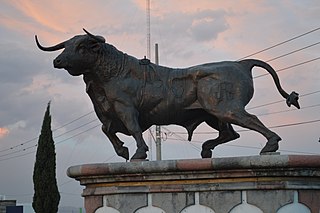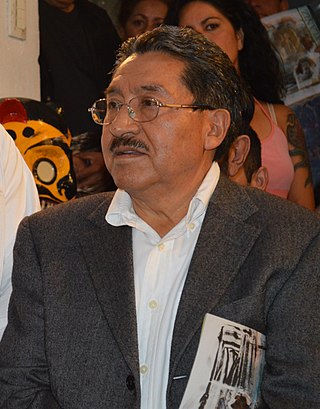
Tlaxcala, officially Tlaxcala de Xicohténcatl, is the capital city and of the Mexican state of Tlaxcala and seat of the municipality of the same name. The city did not exist during the pre-Hispanic period but was laid out by the Spanish as a center of evangelization and governance after the Spanish conquest of the Aztec Empire. The city was designated as a diocese but eventually lost that status to Puebla as its population declined. The city still has many of its old colonial structures, including the former Franciscan monastery, and newer civic structures like the Xicohtencatl Theatre.

Tlaxcala, officially the Free and Sovereign State of Tlaxcala, is one of the 32 federal entities that comprise the Federal Entities of Mexico. It is divided into 60 municipalities and the capital city and the largest city is Tlaxcala de Xicohténcatl.

Huamantla is a small city in the municipality of the same name in the eastern half of the Mexican state of Tlaxcala. The area has a long indigenous history, but the city itself was not founded until the early colonial period, in the 1530s. It is mostly agricultural but it is best known for its annual homage to an image of the Virgin Mary called Our Lady of Charity. This includes a month of festivities, the best known of which are the “night no one sleeps” when residents create six km of “carpets” on the streets made from colored sawdust, flowers and other materials. The other is the “Huamantlada” a running of the bulls similar to that in Pamplona.

History of Tlaxcala is an alphabetic text in Spanish with illustrations written by and under the supervision of Diego Muñoz Camargo in the years leading up to 1585.
Diego Muñoz Camargo was the author of History of Tlaxcala, an illustrated codex that highlights the religious, cultural, and military history of the Tlaxcalan people.

Organización Editorial Mexicana, also known as OEM, is the largest Mexican print media company and the largest newspaper company in Latin America. The company owns a large newswire service, it includes 70 Mexican daily newspapers, 24 radio stations and 44 websites.
Tlaxcala Televisión is a public television station operated by the Coordinación de Radio, Cine y Televisión de Tlaxcala (CORACYT) which serves the Mexican state of Tlaxcala. Tlaxcala Televisión's programming primarily consists of cultural and educational content, along with news and sports coverage. It also airs programming from Canal Once, Canal 22, Mexiquense Televisión and DW-TV

Cuautlancingo is a town and municipality in the state of Puebla, south-eastern Mexico. It is part of the Metropolitan area of Puebla. The town is bordered on the north by the state of Tlaxcala, on the east by Tlaxcala and the city of Puebla, on the south by the municipalities of San Pedro Cholula and Puebla, and on the west by the municipality of Coronango.
Most Mexican states do not have an official flag. For these states, a de facto flag is used for civil and state purposes. State flags of Mexico have a 4:7 ratio and typically consist of a white background charged with the state's coat of arms.
The Tlaxcala-Puebla Nahuatl language, also known as Central Nahuatl, is a Nahuan language spoken by 40,000 people in central Mexico.
Ixtenco Otomi, also known as Tlaxcala Otomi, is a native American language spoken in the town of San Juan Bautista Ixtenco in the state of Tlaxcala, Mexico. It has been classified as Eastern Otomi by Lastra (2006). Lastra considers Ixtenco Otomí to be a very conservative dialect.
Desiderio Hernández Xochitiotzin was a Mexican artist best known for his large-scale mural work inside the State Government Palace in the state of Tlaxcala, Mexico, the last large scale mural of the Mexican muralism movement.

Lorena Cuéllar Cisneros is a Mexican politician affiliated with the National Regeneration Movement (MORENA) who serves as the Governor of Tlaxcala. Formerly she served as a member of the Labor Party (PT) as a federal deputy in the LXIV Legislature of the Mexican Congress representing Tlaxcala's third district; she had previously been a senator for Tlaxcala and mayor of the state capital, Tlaxcala de Xicohténcatl.

Hermenegildo Sosa is a Mexican painter and art professor who is best known for colorful depictions of Mexican rural landscapes, especially those of his home state of Tlaxcala. He was born there into a farming family, whose economic condition delayed his education as he had to work from a young age. In his teens he arrived to Mexico City to work as a domestic, but this allowed him to attend school, including painting classes. Eventually, he entered the Escuela Nacional de Pintura, Escultura y Grabado "La Esmeralda", where he eventually gained a career as a professor.

Tlaxcala handcrafts and folk art is that which comes from the smallest state in Mexico, located in the center-east of the country. Its best-known wares are the "canes of Apizaco", sawdust carpets and the making of Saltillo-style serapes. However, there are other handcraft traditions, such as the making of pottery, including Talavera type wares, cartoneria, metalworking and stone working. The state supports artisans through the activities of the Fideicomiso Fondo de la Casa de las Artesanía de Tlaxcala

Tlaxcala Fútbol Club, commonly known as Coyotes de Tlaxcala, is a Mexican football club based in Tlaxcala (city), Tlaxcala, Mexico. The club was founded in 2014, and currently plays in the second tier, Liga de Expansión MX. Tlaxcala won automatic promotion to Ascenso MX in the 2016–17 season, but their promotion was put on hold until the 2018–19 season as their stadium failed to meet league requirements. However, in 2020 the club was invited to the Liga de Expansión, the new second-level league and thus promoted category.

Federal Highway 117D is the designation for two toll highways in eastern Mexico.
Same-sex marriage has been legal in Tlaxcala since 25 December 2020. Legislation to legalise same-sex marriage passed the Congress of Tlaxcala on 8 December 2020 by a vote of 16–3, and came into force on 25 December. Tlaxcala has also recognised civil unions, which grant several of the rights and benefits of marriage, for both opposite-sex and same-sex couples since 12 January 2017.
Joel Molina Ramírez was a Mexican politician and senator representing the state of Tlaxcala from the National Regeneration Movement (MORENA) party. He served in the LXIV Legislature of the Mexican Congress from February 2019 until his death in office from COVID-19 during the COVID-19 pandemic in Mexico in October 2020, seven days short from his 78th birthday.














